-
Article
-
Effects of Hallasan Mountain in Jeju Island on Typhoon’s Track and Intensity
태풍의 진로와 강도에 있어 제주도 한라산의 영향
-
Se-Won Do, Il-Ju Moon
도세원, 문일주
- This study examines the influence of Hallasan Mountain (Hallasan) on the track and intensity of two Typhoons, Soulik in 2018 and Chaba …
- This study examines the influence of Hallasan Mountain (Hallasan) on the track and intensity of two Typhoons, Soulik in 2018 and Chaba in 2016, which passed to the left and right of Hallasan, respectively, using a coupled ocean-atmosphere model. We designed three experiments: one with Hallasan's actual altitude, another with the mountain removed, and a third where Hallasan's altitude was doubled. Results showed that Hallasan had a negligible impact on the tracks of both typhoons. Regarding intensity, however, the central pressure of both typhoons increased (indicating weakening) by up to 2 hPa due to Hallasan; the maximum wind speeds initially increased (Soulik by 1 m/s, Chaba by 3 m/s) and then decreased (Soulik by 1 m/s, Chaba by 5 m/s). These results show that Hallasan does not significantly weaken the intensity of typhoons approaching the Korean Peninsula, but considering the average intensity change (–3.45 hPa) of past typhoons that passed to the left of Jeju Island in terms of central pressure, Hallasan makes a noteworthy contribution. Additionally, this study reveals that changes in typhoon winds due to the wind convergence caused by Hallasan's topography can alter ocean vertical mixing and sea surface cooling, further impacting typhoon intensity. This finding underscores the importance of using a coupled ocean-atmosphere model when studying the impact of topography on typhoons. - COLLAPSE
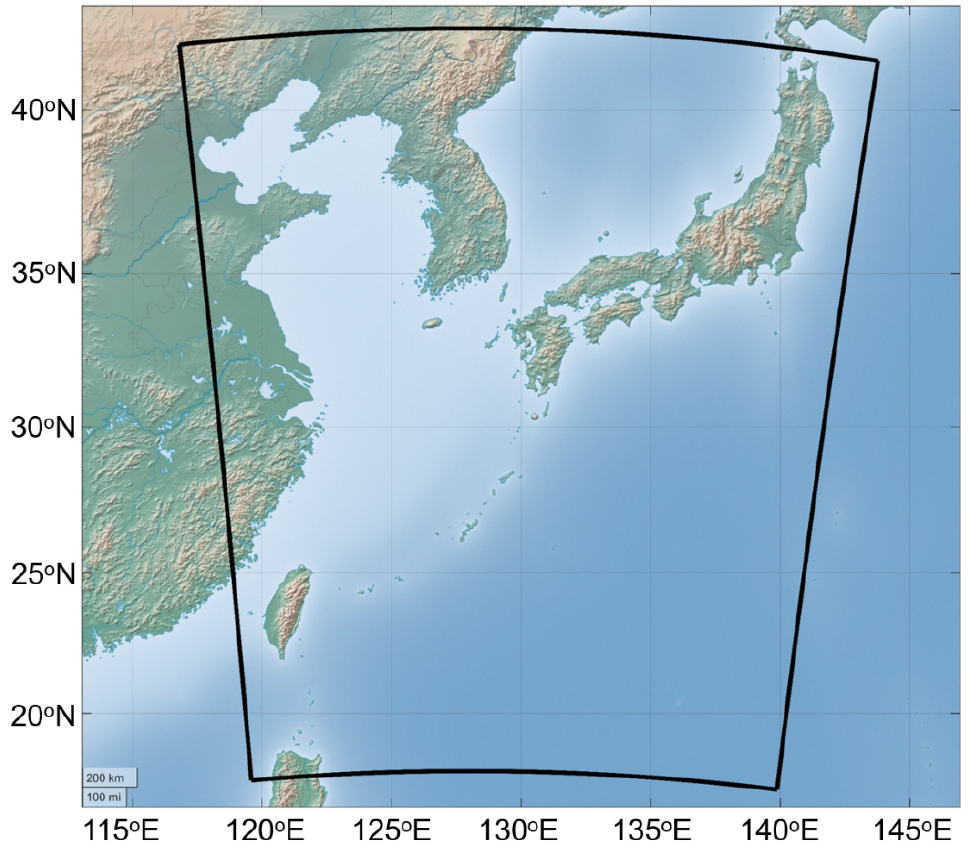
-
Effects of Hallasan Mountain in Jeju Island on Typhoon’s Track and Intensity
-
Article
-
Bias-Aware Numerical Surface Temperature Prediction System in Cheonsu Bay during Summer and Sensitivity Experiments
편향보정을 고려한 수치모델 기반 여름철 천수만 수온예측시스템과 예측성능 개선을 위한 민감도 실험
-
Young-Joo Jung, Byoung-Ju Choi, Jae-Sung Choi, Sung-Gwan Myoung, Joon-Young Yang, Chang-Hoon Han
정영주, 최병주, 최재성, 명성관, 양준용, 한창훈
- A real-time numerical prediction system was developed to predict sea surface temperature (SST) in Cheonsu Bay to minimize damages caused by marine …
- A real-time numerical prediction system was developed to predict sea surface temperature (SST) in Cheonsu Bay to minimize damages caused by marine heatwaves. This system assimilated observation data using an ensemble Kalman filter and produced 7-day forecasts. Bias in the temperature forecasts were corrected based on observed data, and the bias-corrected predictions were evaluated against observations. Using this real-time numerical prediction system, daily SSTs were predicted in real-time for 7 days from July to August 2021. The forecasted SSTs from the numerical model were adjusted using observational data for bias correction. To assess the accuracy of the numerical prediction system, real-time hourly surface temperature observations as well as temperature and salinity profiles observed along two meridional sections within Cheonsu Bay were compared with the numerical model results. The root mean square error (RMSE) of the forecasted temperatures was 0.58°C, reducing to 0.36°C after bias-correction. This emphasizes the crucial role of bias correction using observational data. Sensitivity experiments revealed the importance of accurate input of freshwater influx information such as discharge time, discharge volume, freshwater temperature in predicting real-time temperatures in coastal ocean heavily influenced by freshwater discharge. This study demonstrated that assimilating observational data into coastal ocean numerical models and correcting biases in forecasted SSTs can improve the accuracy of temperature prediction. The prediction methods used in this study can be applied to temperature predictions in other coastal areas. - COLLAPSE
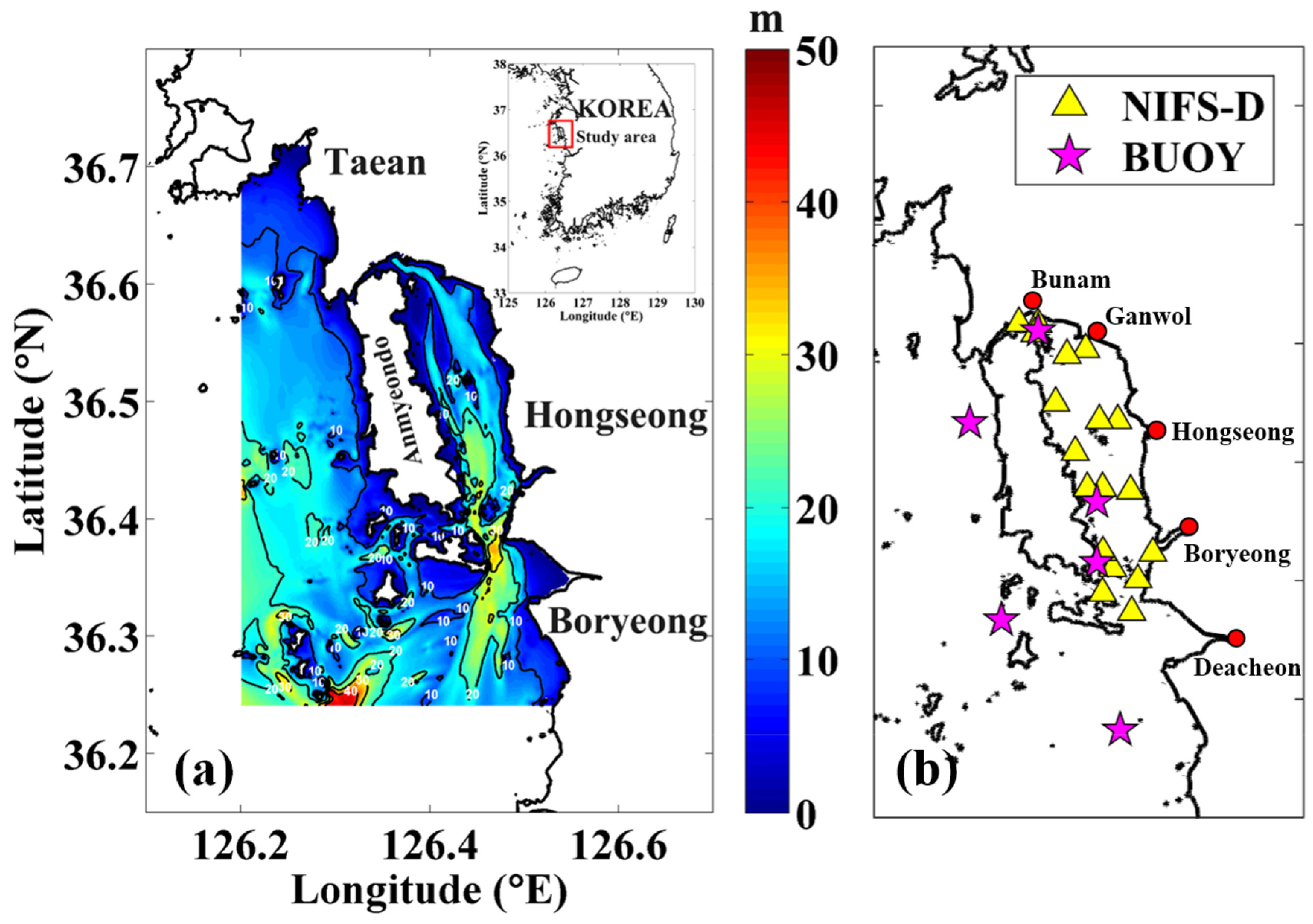
-
Bias-Aware Numerical Surface Temperature Prediction System in Cheonsu Bay during Summer and Sensitivity Experiments
-
Article
-
A Process-based Relative Sea-level Budget Along the Coast of Korean Peninsula Over 1993–2018
1993–2018년 한반도 연안 상대해수면 수지 분석
-
Hyeonsoo Cha, Seongbae Jo, Jae-Hong Moon
차현수, 조성배, 문재홍
- Due to physical processes varying in space and time, regional sea-level rise (SLR) significantly deviates from the global mean. Thus, understanding and …
- Due to physical processes varying in space and time, regional sea-level rise (SLR) significantly deviates from the global mean. Thus, understanding and quantifying the contribution of each process to regional sea-level change is crucial to prevent low-lying inundation in preparation for future ocean conditions. In this study, we assessed to what degree sterodynamic (SD) effects (i.e., density-driven steric expansion and mass redistribution due to ocean circulation), contemporary mass redistribution (CMR), and glacial isostatic adjustment (GIA) contribute relative sea-level rise around the Korean coast from 1993 to 2018, with independent observations and reanalysis datasets. The assessment showed that the tide gauge-observed SLR trend can be explained by the sum of each component at 16 of 19 locations. The major contributors to relative SLR are SD effects of 2.03±0.27 mm/yr and CMR components of 1.31±0.05 mm/yr, while GIA drives sea-level decreasing of -0.27±0.15 mm/yr on the Korean coast. It was also found that the spatial deviations of SLR are primarily caused by the SD effects. In addition, the evaluation of vertical land motion (VLM) based on altimetry and tide gauge indicates that most tide gauge locations have experienced uplift during at least altimetry period, whereas Wido station has experienced particularly high rate of subsidence that contributed to the SLR acceleration. Further examination of the impact of earth deformation due to CMR, GIA, and local process on the VLM trends demonstrated that the GIA and CMR contribute to land uplift with the average of 0.35±0.15 mm/yr and 0.17±0.05 mm/yr, respectively. On the other hand, the local processes like groundwater depletion and sediment compaction showed a wide range of variability, from -1.61 to 0.58 mm/yr, indicating a significant contribution to regional differences in vertical land motion. - COLLAPSE
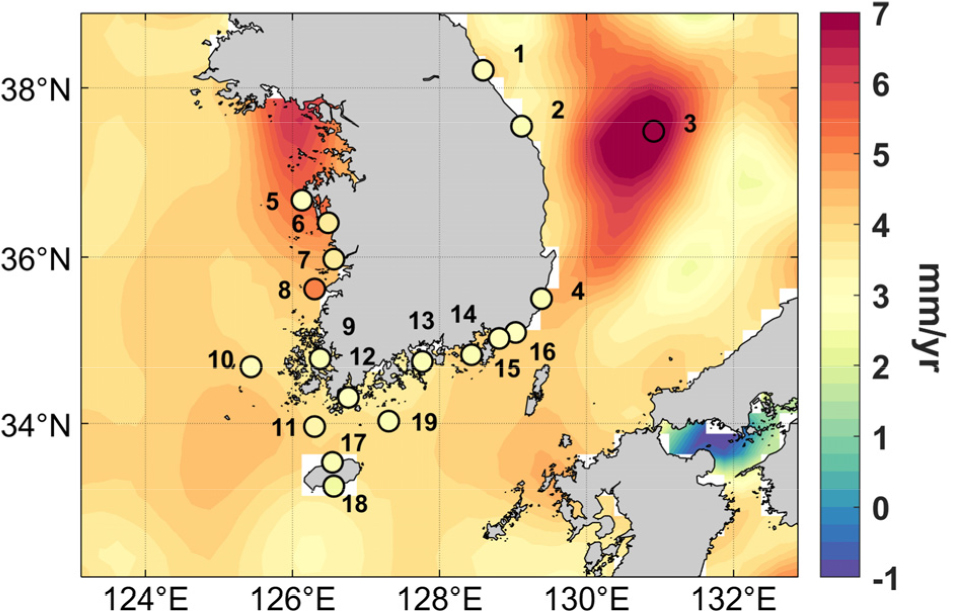
-
A Process-based Relative Sea-level Budget Along the Coast of Korean Peninsula Over 1993–2018
-
Article
-
Identification of Environmental and Phytoplankton Fluctuation Patterns in Jinhae Bay, South Sea: Focusing on Harmful Plankton from 2017 to 2022
남해 진해만의 환경 및 식물플랑크톤 변동 패턴: 2017–2022년 유해 플랑크톤을 중심으로
-
Han-Sol Kim, Taehee Kim, Tae-Gyu Park, Jang-Seu Ki
김한솔, 김태희, 박태규, 기장서
- This study investigated recent seasonal changes in the phytoplankton community in the southern coast of Korea, analyzing monthly samples collected at four …
- This study investigated recent seasonal changes in the phytoplankton community in the southern coast of Korea, analyzing monthly samples collected at four stations (St.1–4) in Jinhae Bay from 2017 to 2022. Environmental factors except nutrients were similar each station. Water temperature ranged from 6.0 to 29.0°C and DO ranged from 2.7 to 11.6 mg L-1 with salinity ranging from 25.9 to 33.8 psu. There was no significant differences in environmental factors between stations except for nutrients. Phytoplankton cell concentrations ranged from 5.0×103 cells L-1 to 7×105 cells L-1, with patterns similar to chlorophyll-a at each site. Phytoplankton taxa identified here were 42 genera and 77 species, including 49 diatoms, 27 dinoflagellates, and one Dictyochophyceae species. Diatoms dominated throughout all monitoring stations and seasons; however, dinoflagellates exhibited sporadic patterns during spring seasons. Nine harmful phytoplankton were identified, including one diatome Psuedo-nitzschia and eight dinoflagellate Alexandrium spp., Akashiwo sanguinea, Margalefidinium polykrikoides, Dinophysis spp., Gymnodinium spp., Pheopolykrikos hartmannii, Polykrikos kofoidii and Prorocentrum spp. The appearance pattern of the harmful phytoplankton showed a high correlation with seasonal factors. This study provides fundamental data on the composition of phytoplankton and their relationship with environmental factors in Jinhae Bay. In addition, they may be useful for understanding long-term changes in harmful phytoplankton in the southern coasts of Korea. - COLLAPSE
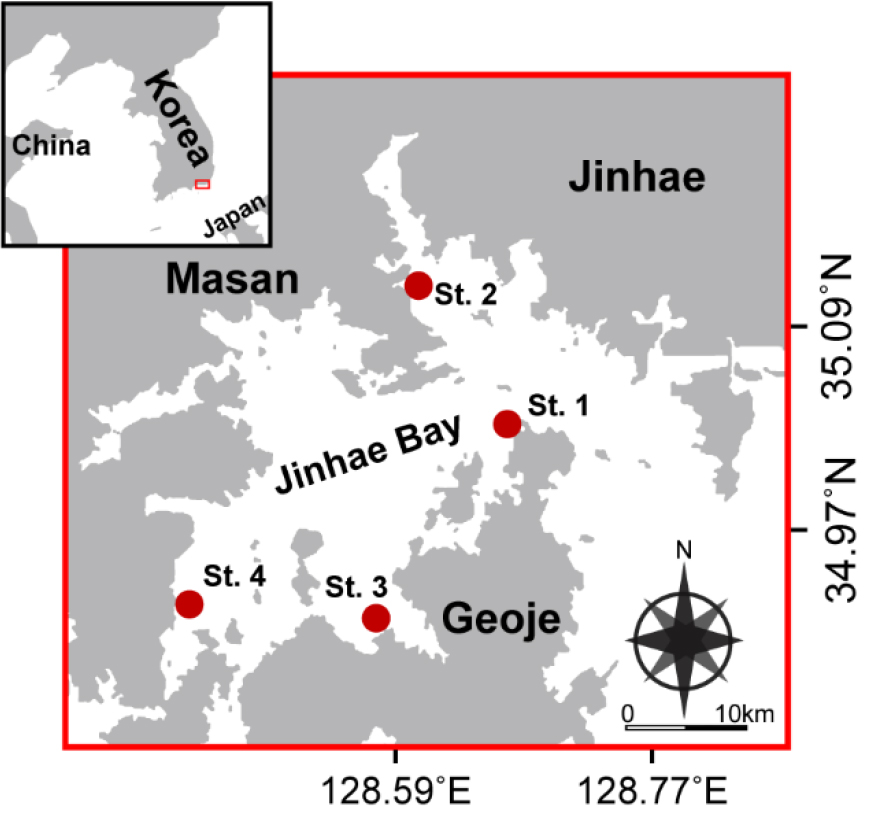
-
Identification of Environmental and Phytoplankton Fluctuation Patterns in Jinhae Bay, South Sea: Focusing on Harmful Plankton from 2017 to 2022
-
Article
- Effects of Red LED Spectra and Different Photoperiods on the Circadian Rhythm of Abalones (Haliotis discus hannai)
- Jin A Kim, Min Ju Kim, Jun-Hwan Kim, Cheol Young Choi
- Light is an external environmental factor that affects the biorhythms of aquatic organisms and is involved in their behavior, reproduction, and various …
- Light is an external environmental factor that affects the biorhythms of aquatic organisms and is involved in their behavior, reproduction, and various biological responses. The biorhythm (24-h cycle) of organisms is controlled internally by clock genes, such as period (Per), cryptochrome (Cry), and melatonin receptor (MT-R), and is externally controlled by light, food, and temperature. In this study, the experimental organisms were divided into photoperiod and LED groups. The photoperiod group was exposed to two photoperiods (LD, 12 h light: 12 h darkness; DD, constant darkness), and the LED group was exposed to a red LED light (wavelength, 630 nm; 12 h LED light: 12 h darkness). Per and Cry mRNA expression levels increased during the bright phase and decreased during the dark phase. MT-R mRNA expression decreased during the bright period and increased during the dark period. The trend in clock gene expression in the RD group was similar to that in the DD group but not in the LD group. Red LED irradiation induced gene expression similar to the 24 h memorization condition, suggesting that long-wavelength light conditions can change the biorhythm of abalones. This study provides academic information on the biorhythm cycle of abalone (a marine gastropod), which is less well known than that of fish and can aid in predicting the physiological response of abalones to changes in light wavelength. - COLLAPSE
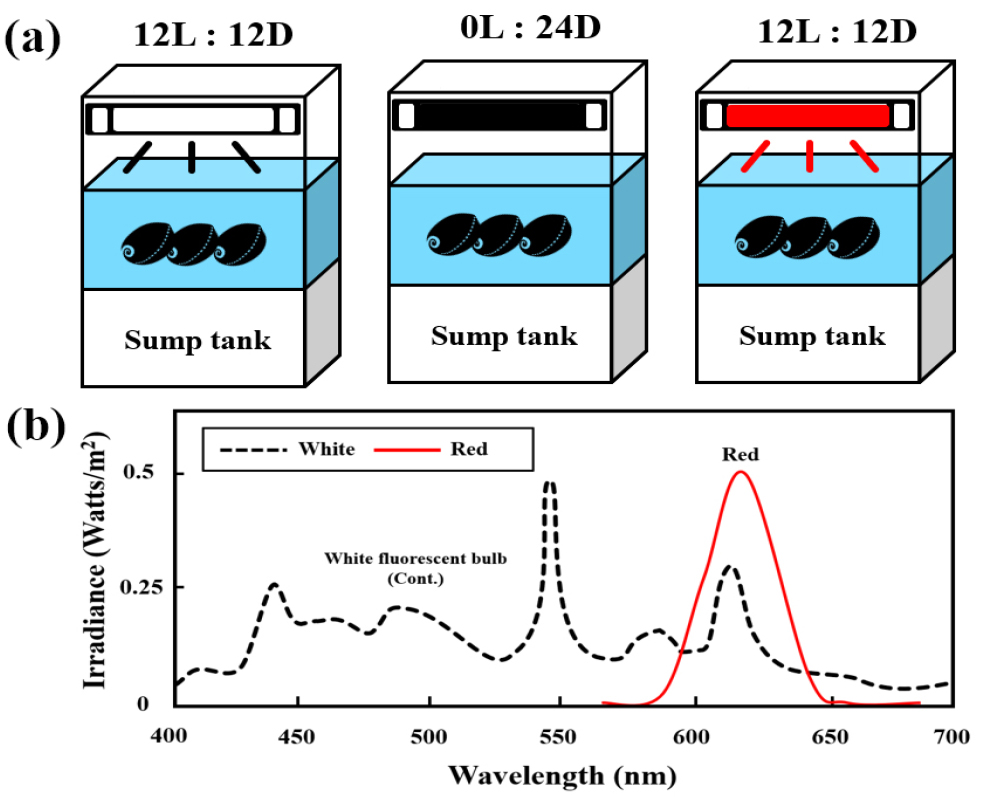
-
Article
- Land Surface Dynamics and Underwater Topography from the Latest DTM Extraction to Measure the Antarctica Ice Sheet Thickness
- Atriyon Julzarika
- The Antarctica ice sheet thickness is one of the important information to know the dynamics of changes in the Earth's environment. Geospatial …
- The Antarctica ice sheet thickness is one of the important information to know the dynamics of changes in the Earth's environment. Geospatial data of the ice sheet surface, land surface and underwater topography, and vertical deformation can be used for ice sheet thickness measurement and calculation. They can be extracted from the latest DTM. The latest DTM is one of the methods and products to extract up-to-date and detailed topography based on the dynamics of the vertical deformation period. This study aims to measure the Antarctica ice sheet thickness based on land surface dynamics and underwater topography from the latest DTM extraction. The vertical accuracy of the DTM, DSM, and vertical deformation uses a 95 % (1.96σ) confidence level. The ice thickness is divided into three types of ice layers according to the reference field: ice thickness above land, ice thickness (above the sea), and ice thickness (underwater). Ice thickness above land has a volume (3,700,299.5 km3), an area (6,767,772 km2), and a total length perimeter (114,569 km). Ice thickness (above the sea) has a volume (28,103,427.8 km3), an area (13,438,789 km2), and a total perimeter length (27,199 km). Ice thickness (underwater) has a volume (1,793,778.6 km3), an area (3,223,036 km2), and a total length perimeter (46,556 km). Antarctica's ice sheet thickness results can be used for various thematic applications of the dynamics of the Earth's environment. - COLLAPSE
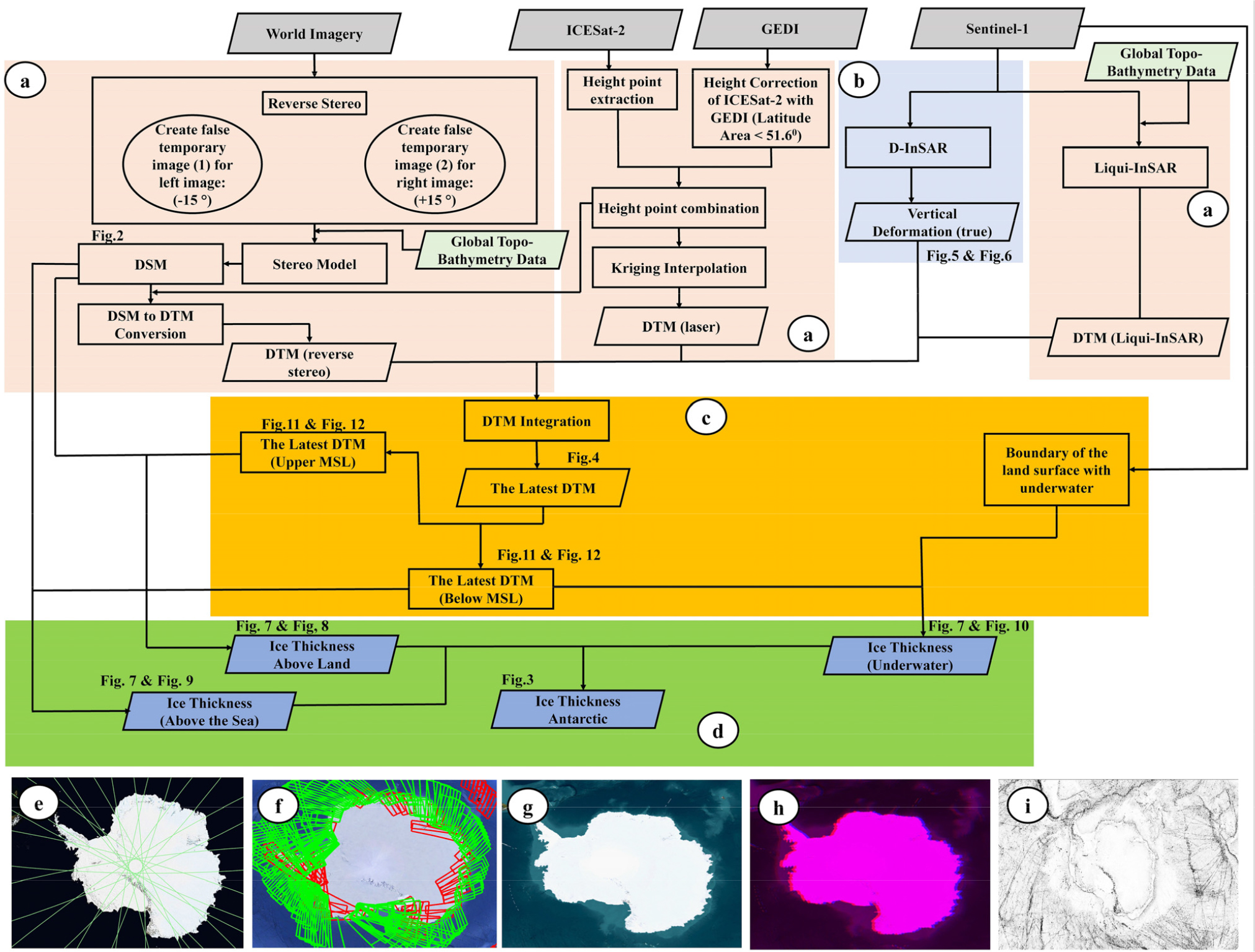
-
Article
-
Performance Improvement of a Darrieus Hydrokinetic Turbine by Interaction and Diffusion Effects
상호작용과 확산 효과를 이용한 다리우스 유체동력 터빈의 성능 향상
-
Dasom Jeong, Jin-Soon Park, Jin Hwan Ko
정다솜, 박진순, 고진환
- In this study, first, we adopted a twin configuration of a Darrieus hydrokinetic turbines that can bring about an improvement in efficiency …
- In this study, first, we adopted a twin configuration of a Darrieus hydrokinetic turbines that can bring about an improvement in efficiency through positive interaction and obtained the optimal shape through parametric analysis of the small-scale turbine model by computational fluid dynamic simulations. Next, the effect of performance improvement was examined for symmetrical and asymmetrical ducts. The results show that the asymmetrical duct that utilizes diffusion effects has a comparative advantage in terms of efficiency and drag over the symmetrical one. However, the advantage of the Darrieus turbine, which has flow-directional independency, is lost in the case of the presented configuration; thus, we introduced the idea of a passive yaw-controller that adapts to the variation of the flow-direction that does not require additional energy consumption. In conclusion, such efforts and adjustments to enhance the performance of the Darrieus turbine by utilizing the interaction and diffusion effects discussed in this study will be helpful in securing competitiveness against other types of hydrokinetic turbines. - COLLAPSE
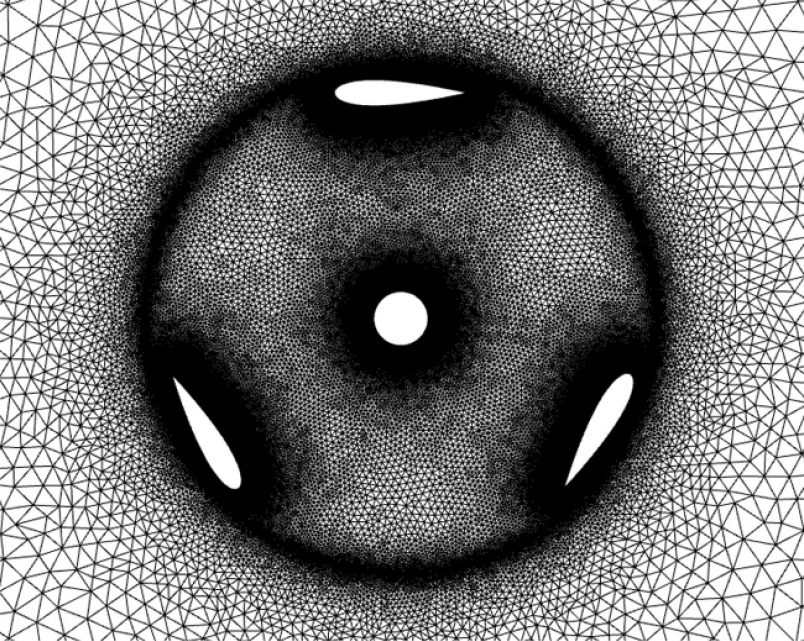
-
Performance Improvement of a Darrieus Hydrokinetic Turbine by Interaction and Diffusion Effects
-
Review
-
Research Trends on the Organic Carbon Cycle in Estuarine Environment in South Korea
하구 환경의 유기탄소 순환에 관한 국내 연구 동향
-
Sujin Kang
강수진
- Estuaries are connecting pathways where terrestrial carbon is transported to the ocean and environments where various biogeochemical cycles occur. It is essential …
- Estuaries are connecting pathways where terrestrial carbon is transported to the ocean and environments where various biogeochemical cycles occur. It is essential to estimate the carbon flux across the land-sea continuum to accurately determine the global carbon budget. Additionally, understanding the carbon characteristics of estuarine environments provides valuable information for watershed management and coastal ecosystem conservation. This paper introduces research results in Korea regarding the organic carbon cycle in estuarine environments. In particular, it focuses on research results concerning organic carbon characteristics using stable and radioisotopes, and, based on this, suggests directions for future study. - COLLAPSE
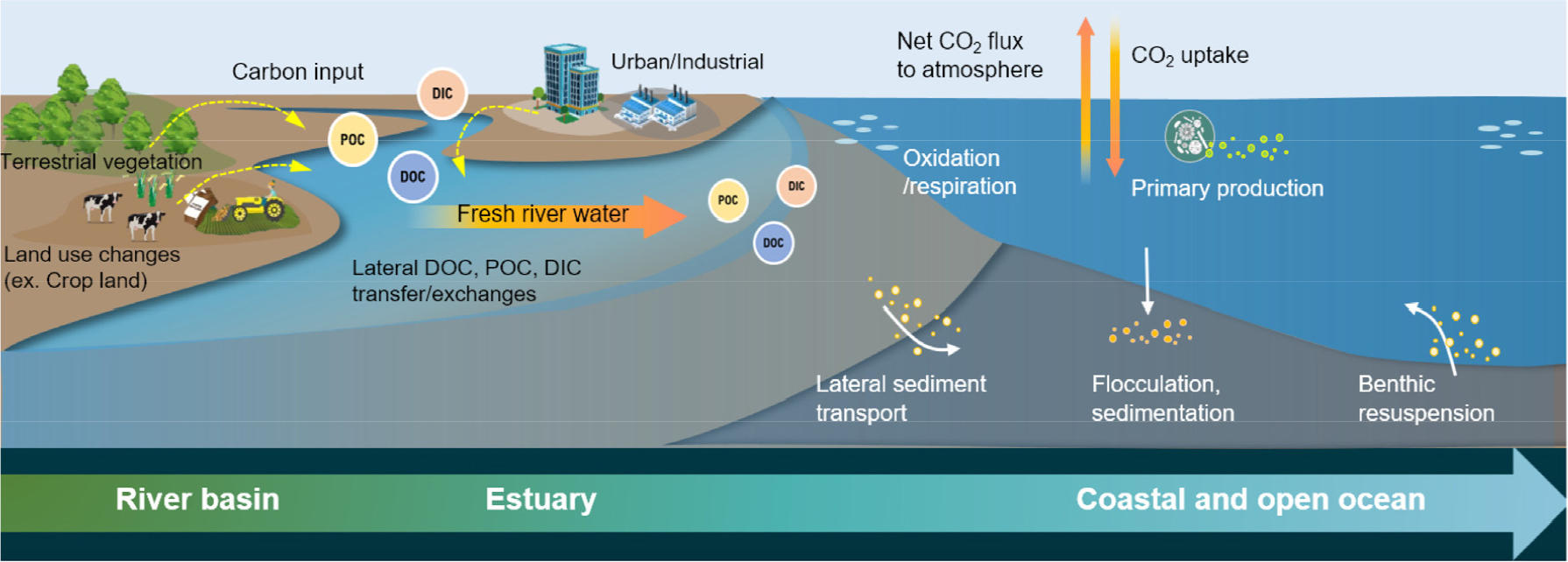
-
Research Trends on the Organic Carbon Cycle in Estuarine Environment in South Korea



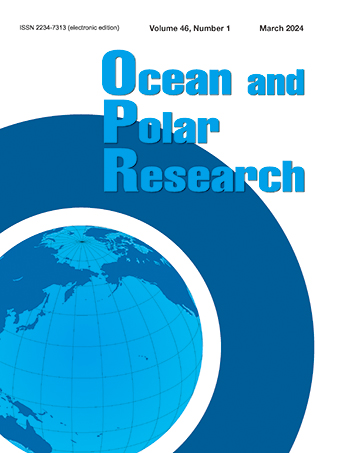 Ocean and Polar Research
Ocean and Polar Research








